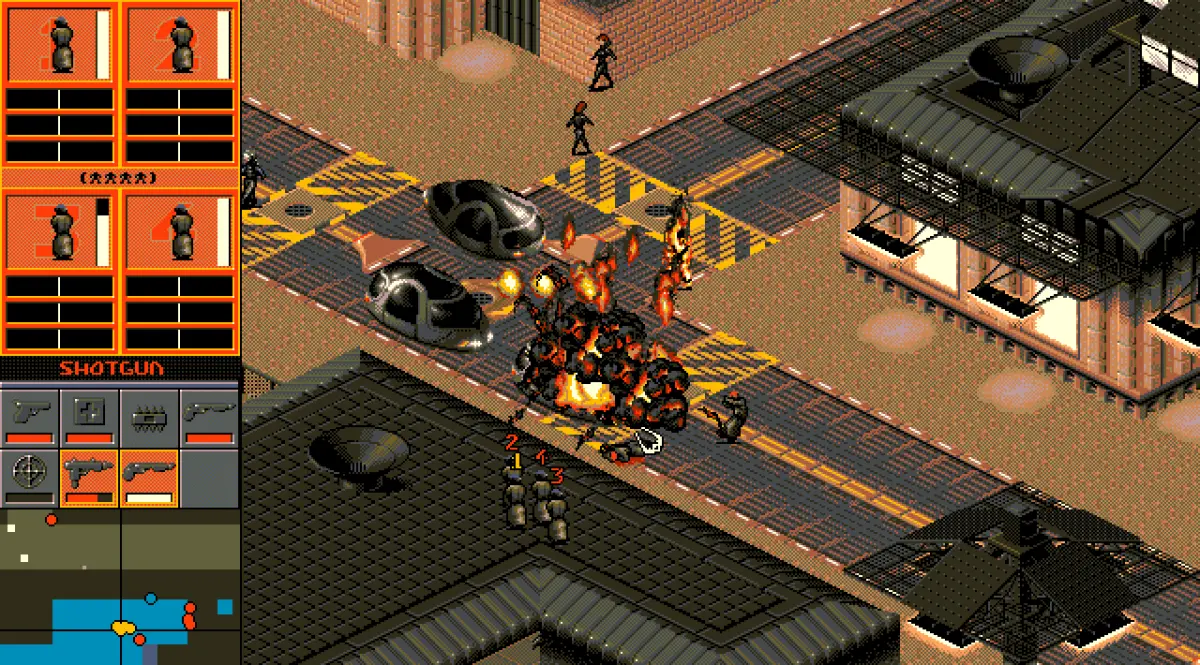Syndicate
- Genre: Strategy
- Players: 1-4
- Developer: Bullfrog Productions
- Publisher: Electronic Arts
Description
Released in 1993 by Bullfrog Productions under the direction of Peter Molyneux, Syndicate painted a bleak vision of the future that still resonates today. Set in 2096, this isometric action-strategy game depicted a world where nations had collapsed, replaced by mega-corporations that battled for supremacy using cyborg agents and devastating weaponry.
"Persuadatron Activated"
As the executive of a rising syndicate, players were tasked with expanding their corporation's influence across 50 global territories through whatever means necessary:
- Assassination of rival executives
- Kidnapping of brilliant scientists
- Protection of corporate assets
- Elimination of competing syndicates
- Tax collection from subjugated populations
This amoral premise set Syndicate apart from other games of its era, refusing to cast the player as a hero and instead embracing the ruthless logic of corporate dominance.
The Agents: Cybernetic Tools of Corporate Warfare
At the player's disposal were up to four cyborg agents, walking weapons platforms that could be upgraded and modified:
- Legs: Determined movement speed and jumping ability
- Arms: Affected accuracy and firing rate
- Chest: Controlled damage resistance
- Head: Governed perception and intelligence
Each agent could be equipped with a variety of weapons, from the humble pistol to the devastating Gauss Gun, Minigun, and the infamous Persuadatron—a device that could brainwash civilians and turn them into temporary allies.
IPA: The Drug-Fueled Combat System
Perhaps most controversial was the game's drug system. Agents could be injected with three types of performance-enhancing substances:
- Intelligence-enhancing drugs: Improved accuracy and perception
- Perception-accelerating drugs: Slowed down perceived time for better reactions
- Adrenaline: Increased speed and strength
By administering these substances through a simple interface in the corner of the screen, players could push their agents beyond human limitations—but at the cost of eventual addiction and diminishing returns.
A Living, Breathing Dystopia
Syndicate's city environments were remarkably interactive for their time:
- Civilians wandered the streets, going about their daily lives
- Police forces responded to player violence
- Cars and vehicles navigated roadways and could be commandeered
- Buildings could be entered and explored
- Windows shattered, objects exploded, and bodies remained where they fell
This created a sandbox feel that was revolutionary in 1993, allowing for emergent gameplay as players developed their own approaches to missions.
The Isometric Perspective
The game's isometric viewpoint provided a god-like perspective on the unfolding chaos:
- Streets and buildings appeared in detailed 3D-like environments
- Lighting effects created day and night atmospheres
- Scrolling was smooth and responsive
- Zoom functionality allowed for strategic oversight or close-quarters management
This visual approach would influence countless strategy games that followed, proving that 3D wasn't necessary for creating an immersive world.
The Research Tree
Between missions, players developed new technologies through a research system:
- Weapons research unlocked increasingly powerful armaments
- Cybernetic modifications enhanced agent capabilities
- Defense systems improved survivability
- Medical advances allowed for faster healing and recovery
This progression system created a satisfying power curve, transforming agents from vulnerable operatives to nearly unstoppable killing machines by the game's conclusion.
Sound Design: The Atmosphere of Oppression
Syndicate's audio landscape contributed significantly to its dystopian mood:
- The iconic "ping" sound when selecting agents
- The mechanical whirr of cybernetic modifications
- The distinctive reports of different weapons
- The screams of civilians caught in crossfire
- The ambient sounds of city life continuing amid violence
Combined with a minimalist soundtrack that emphasized tension over melody, these audio elements created an atmosphere of clinical detachment that perfectly matched the game's themes.
Tactical Depth Behind the Violence
While Syndicate could be played as a straightforward action game, success in later missions demanded tactical thinking:
- Positioning agents to create crossfire
- Using buildings and terrain for cover
- Timing drug administration for maximum effect
- Deploying the right weapons for specific situations
- Coordinating agent movements for ambushes and flanking maneuvers
This layered gameplay ensured that Syndicate remained challenging throughout its campaign, requiring both quick reflexes and strategic planning.
The Legacy of Corporate Dominance
Syndicate's influence can be seen across gaming history:
- Its blend of action and strategy influenced titles like X-COM and Jagged Alliance
- Its cyberpunk aesthetic helped define the visual language of the genre in gaming
- Its amoral perspective challenged conventions about player motivation
- Its uncompromising difficulty set a standard for strategic depth
The game would receive a well-regarded expansion (Syndicate: American Revolt), a sequel (Syndicate Wars), and an ill-fated FPS reboot in 2012. None, however, captured the precise alchemy of the original.
A Prophecy in Pixels
What remains most striking about Syndicate today is how much of its dystopian vision has come to seem plausible:
- The rise of corporate power over national governance
- The increasing prevalence of surveillance technology
- The widening gap between the elite and the masses
- The commodification of human beings as resources
In creating what was intended as an exaggerated, dark future, Bullfrog inadvertently crafted a warning that grows more relevant with each passing year.
For those who commanded their agents through its neon-lit streets, Syndicate remains more than just a game—it stands as a formative experience that helped us understand the darker possibilities of our collective future, all while delivering an engrossing gaming experience that balanced challenging gameplay with a thought-provoking premise.
"Objective complete. Awaiting further instructions."
This post contains affiliate links. If you click through and make a purchase, I may receive a small commission at no extra cost to you.
